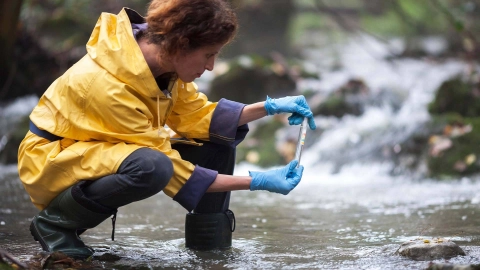Healthy living Hospital hygiene – preventing infections in medical facilities
People who are seriously ill or have recently had surgery are usually more at risk of infection. Various measures are taken to prevent infection with disease-causing microbes in hospitals and medical facilities. Read on to find out about typical hospital-acquired infections and the hygiene measures taken to prevent them.
At a glance
- The most frequent infections that people pick up in hospital settings are bacterial. Fungal and viral infections are less common.
- Certain factors, such as age and the patient’s underlying condition, as well as the duration of surgery and use of antibiotics, increase the risk of infection.
- The majority of disease-causing microbes in hospitals are transmitted by touch, which makes hand hygiene the most important hygiene control measure.
- Other important measures are protective clothing and vaccinations for hospital staff, as well as isolation of infected patients and hygiene precautions during surgery.
- Specialist hygiene personnel ensure that all required measures are taken and standards are observed.

What are hospital-acquired infections and what is hospital hygiene?
Hospital-acquired infections or healthcare-associated infections (also known by medical professionals as “nosocomial infections”) are any infection that a person picks up while being cared for in a medical facility. These facilities include not only hospitals but also care and rehabilitation facilities and medical practices. However, as the risk of infection is highest is hospital settings, they are most commonly known as hospital-acquired infections (HAIs).
People are more likely to acquire infections in hospitals than in other settings because hospital patients often already have a weakened immune system, for example due to a serious illness or following surgery. This means that their immune system is less able to fight off infection with disease-causing microbes. Fresh surgical wounds are also easily infected because these do not have a natural skin barrier to provide protection against the entry of microbes into the body.
There are many infection control measures that can be taken to prevent patients in hospitals or other medical facilities from acquiring an infection. These measures are referred to under the umbrella term “hospital hygiene”. All medical facilities must have trained hygiene personnel and a hygiene plan in place that lists all hygiene control measures implemented. In addition to hand hygiene, protective clothing and disinfection play an important role. Hygiene standards must be observed by doctors, nursing and surgical staff, patients and visitors.
Which pathogens are frequently responsible for hospital-acquired infections?
People can acquire infections with many different pathogens – i.e. disease-causing microbes – in medical facilities such as hospitals and clinics. These pathogens may be bacteria, fungi or viruses. The most common diseases caused by these pathogens are infections of the lower respiratory tract, such as pneumonia, followed by surgical wound infections and urinary tract infections (UTIs). Diarrhea is also common, in particular diarrhea caused by Clostridioides difficile bacteria.
Bacteria
The majority of hospital-acquired infections are caused by bacteria. Most of these bacteria present no risk to healthy individuals. Many people carry these bacteria without ever noticing. However, for people with a weakened immune system (e.g. following surgery), with a severe illness like cancer, or those taking certain medications, these bacteria can be dangerous.
The following types of bacteria are particularly likely to be responsible for hospital-acquired infections:
- Pseudomonas, in particular Pseudomonas aeruginosa: These bacteria are widespread in the environment. They can trigger a range of infections in people with a weakened immune system, including lung infections and wound infections.
- Enterococci: These are a group of intestinal bacteria that can infect various parts of the body.
- Klebsiella: These intestinal bacteria can cause infections such as pneumonia, urinary tract infections and meningitis.
- Clostridioides difficile: These intestinal bacteria can cause intestinal inflammation with severe diarrhea.
- Staphylococci, especially Staphylococcus aureus: These bacteria can cause infections of the skin, wounds and organs.
Fungi
Fungal infections in hospital are less common. The most frequent fungal infections acquired in hospitals are yeast fungi belonging to the genus Candida, e.g. Candida albicans. For healthy people, this is another microbe that generally presents no threat and can live unnoticed on the skin and mucous membranes. However, it can cause a yeast infection known as candidiasis in people who are already ill or in a weakened condition. This can affect various parts of the body, such as the mouth, skin or internal organs.
Viruses
Viruses transmitted via blood, such as hepatitis B, hepatitis C or HIV infections, are very rare. Viral infections of the respiratory tract (airways), such as flu, or viral diarrhea (e.g. norovirus infections) are more common in hospitals.
How can infections spread?
Contact with an infected person is normally required in order to pick up an infection. This contact may be direct or indirect contact. Direct contact includes having a conversation with someone, shaking their hand or providing them with medical treatment. When this type of contact occurs, disease-causing microbes may pass between people through tiny droplets of saliva or through touch. Indirect contact with an infection person can occur, for example, when touching door handles, toilet seats or medical devices.
Important: Hospital-acquired infections are most commonly spread by touch. This is why good hand hygiene is so important in medical facilities – for staff, patients and visitors alike.
During surgical procedures, infections can be spread by surgical staff or by instruments that have not been properly sterilized and, as a result, are not completely free of germs. However, infections can also be triggered by pathogens that were already established in the patient’s body. This can happen when the pathogens access parts of the body where they are not normally found. The skin and gut are normally host to a large number of bacteria. During an operation on the bowel, for example, or any time an incision is made in the skin (as happens during most surgical procedures), the surgical site may become infected with bacteria.
How great is the risk of picking up an infection in hospital?
Infections are the most common side-effect of a hospital stay. In the European Union, around 6 percent of patients will pick up a hospital-acquired infection during their hospital stay. The corresponding figure in Germany is around half a million people, with between 10,000 and 20,000 dying from their infections every year.
While hospital-acquired infections are a serious concern, only a small fraction of patients will be affected by one during their hospital stay. However, certain people are always at an increased risk of picking up infections, including hospital-acquired infections.
At-risk groups and risk factors
The following groups of people are at an increased risk of picking up a hospital-acquired infection:
- older people
- people whose immune system is suppressed by medication, for example, following an organ or stem cell transplant
- people with (several) underlying conditions, such as diabetes or AIDS
- smokers
- people suffering from malnutrition and people who are severely overweight (obese)
Catheters can also increase the risk of infection. Urinary catheters are responsible for almost two-thirds of urinary tract infections. Venous catheters are also frequently used in medical treatments. If a catheter is contaminated with pathogens or if hygiene standards are not adequately observed, catheter-related sepsis (bloodstream infection) may occur. The risk of infection increases with the amount of time the catheter remains in the patient’s body. When a catheter is being inserted or used, microbes may get into the catheter (e.g. from the skin of the patient or the hospital staff member) and multiply over an extended period. The risk of infection during surgery similarly increases with the length of time it takes to complete the procedure.
Another factor that increases the risk of infection is use of antibiotics within the past 90 days or during the hospital stay. This is because antibiotics not only kill harmful bacteria but also “friendly”, useful bacteria that live on the skin and in the gut. This helps pave the way for harmful bacteria and fungi to colonize the body. Use of antibiotic medication is a significant risk factor for infection with Clostridioides difficile bacteria in particular.
Why do antibiotic-resistant pathogens present a particular problem?
Among hospital-acquired infections, a particular risk is posed by antibiotic-resistant – and especially multi-resistant – bacteria. As these bacteria are insensitive to many or even all available antibiotics, it is very difficult and, in some cases, impossible, to treat the infections they cause. Antibiotic-resistant bacteria include:
- Methicillin-resistant Staphylococcus aureus (MRSA)
- Ephalosporin resistant Enterobacteriaceae, such as Klebsiella pneumoniae
- Vancomycin-resistant enterococci (VRE), such as Enterococcus faecium
How is infection control ensured?
In Germany, the Infectious Diseases Protection Act (“Infektionsschutzgesetz”, IfSG) provides a legal basis for hospital hygiene and all associated measures. Recommendations by the Commission for Hospital Hygiene and Infection Prevention (KRINKO) also play an important role. In order to implement the IfSG and KRINKO recommendations, every medical facility employs specialist hygiene personnel and at least one hospital hygienist. This is a doctor with specialized knowledge of hygiene and microbiology. Part of their role is to prevent hospital-acquired infections by implementing appropriate measures and, where necessary, identifying cases of such infections and notifying the relevant authorities.
Medical facilities also need to have a hygiene plan in place, which defines all required hygiene precautions. The facility’s hygiene committee advises on the measures required. The committee comprises, among others, doctors, the hospital hygienist, nursing staff and specially trained hygiene personnel.
What measures are used to prevent infection in healthcare facilities?
The precautions apply to all areas and all people present in the medical facility. These include doctors, nursing and surgical staff, patients and visitors, all of whom must observe the measures set out in the hygiene plan.
Hand hygiene
Observing good hand hygiene plays a particularly important role in protecting oneself and others from infection.
Thorough handwashing with soap is generally sufficient in everyday life. However, in medical facilities, it is sometimes necessary for patients or visitors to not only wash their hands but to also use a disinfectant handrub. The general recommendation of the Commission for Hospital Hygiene and Infection Prevention (KRINKO) is that patients and visitors should disinfect their hands in the following situations:
- when entering the patient’s room
- when leaving the patient’s room
- before eating
- after using toilet facilities
- before and after touching their own wounds or mucus membranes
- before entering high-risk areas
- after contact with surfaces
Important: Medical staff must disinfect their hands thoroughly before and after all contact with patients, as well as after contact with bodily fluids, such as blood.
The following instructions should be followed when disinfecting hands:
- Remove rings from fingers beforehand.
- How much disinfectant to use: Use as much as can fit into the palm of a cupped hand (3-5 ml) to ensure that the entire surface of both hands is covered for a sufficient amount of time.
- For most disinfectants, the recommended application time is 30 seconds.
- Particular attention should be paid to the fingertips, nail beds and thumbs when rubbing the hands with disinfectant.
- Remember to also rub between the fingers.
More information (in German and English) about hand hygiene in hospitals is provided on the website of the national hand hygiene campaign “Aktion Saubere Hände”.
Managing contact with (potentially) infected patients
Some people are at an increased risk of infection with critical pathogens even before they are admitted to hospital. For example, MRSA is more common among farmers than the general population. For at-risk individuals, a screening test for the relevant pathogens is usually performed when they are admitted to hospital.
Patients who are known or suspected to have an infection with critical pathogens, such as MRSA or Clostridioides difficile, are normally cared for in a single room. When entering the room of an infected person, both hospital staff and visitors should wear a protective gown with long arms and disposable gloves. Any care aids or medical devices needed (such as a thermometer) should be left in the patient’s room if possible. Any materials or items that are needed for other patients must be disinfected thoroughly after use.
Vaccination of medical staff
Medical staff are vaccinated against infectious diseases as an additional infection control method to supplement hygiene measures.
Various vaccinations are required or recommended, depending on how often the staff have contact with patients and, especially, how often they have contact with particularly at-risk patient groups (e.g. in intensive care units). For example, if staff have regular contact with particularly at-risk patient groups, they are required to have vaccinations against measles, mumps, rubella and chickenpox, and are also advised to have vaccinations against flu and whooping cough. However, directors of healthcare facilities can also make further vaccinations a requirement for their staff if they regard these as essential to the prevention of infectious diseases. The Commission for Hospital Hygiene and Infection Prevention (KRINKO) recommends a generally high level of vaccination coverage among staff in medical facilities in order to provide the best possible protection for patients from infectious diseases.
What special precautions are taken during surgical procedures?
Hygiene is particularly important during surgery. Wound infections following surgery are among the most common hospital-acquired infections. For this reason, many precautions and measures are taken to ensure that patients are protected from infection as effectively as possible during surgery.
Hygiene measures for staff
Any person entering the operating room must wear special surgical clothing (scrubs) and shoes. Before a surgical procedure, all staff must also put on a surgical face mask over their nose and mouth and cover their hair in a hair net. Before entering the operating room, all surgical staff must also wash their hands and lower arms and disinfect them with a disinfectant handrub, using the proper application technique and for the amount of time specified by the manufacturer. This procedure is referred to as surgical hand disinfection. Once their hands and lower arms are completely dried, staff must put on sterile disposable gloves.
Interesting fact: All devices and instruments used for medical procedures must be “sterile”. This means that they must not be contaminated with any disease-causing germs. In other words, they must be germ-free or pathogen-free.
Preparations for patients
Before surgery, the patient’s skin around the surgical site is washed thoroughly and disinfected using a special antiseptic skin solution. This step is intended to prevent pathogens that live on the skin from entering the surgical wound.
Materials, devices and operating room
All materials and devices used in the operating room are either disposable products or are sterilized following each use. Sterilization is performed by specially trained employees in the hospital’s sterile services department (CSSD). In addition, the entire operating room, including the floor, is disinfected after each operation.
Where to go for more information about hospital hygiene
The website keine-keime.de provides extensive information about hospital hygiene, including videos and an interactive graphic (in German).
- Bundesministerium für Gesundheit (BMG). Krankenhaushygiene. Aufgerufen am 30.08.2021.
- Dettenkofer M, Frank U, Just H-M, et al. Praktische Krankenhaushygiene und Umweltschutz. 4. Auflage. Springer: Berlin 2018.
- Deutsche Gesellschaft für Krankenhaushygiene e.V. (DGKH). Maßnahmenplan für multiresistente gramnegative Erreger (MRGN) in Gesundheits-/Pflege- und Betreuungseinrichtungen. Hygiene & Medizin 2016.
- Kommission für Krankenhaushygiene und Infektionsprävention (KRINKO) und Robert-Koch-Institut (RKI). Empfehlungen zur Prävention und Kontrolle von Methicillin-resistenten Staphylococcus aureus-Stämmen (MRSA) in medizinischen und pflegerischen Einrichtungen. Bundesgesundheitsblatt 2014. 57: 696-732.
- Kommission für Krankenhaushygiene und Infektionsprävention (KRINKO) und Robert-Koch-Institut (RKI). Händehygiene in Einrichtungen des Gesundheitswesens. Bundesgesundheitsblatt 2016. 59: 1189-1220.
- Kommission für Krankenhaushygiene und Infektionsprävention (KRINKO) und Robert-Koch-Institut (RKI). Hygienemaßnahmen bei Clostridioides difficile-Infektion (CDI). Bundesgesundheitsblatt 2019. 62: 906-923.
- Kommission für Krankenhaushygiene und Infektionsprävention (KRINKO) und Robert-Koch-Institut (RKI). Impfungen von Personal in medizinischen Einrichtungen in Deutschland: Empfehlung zur Umsetzung der gesetzlichen Regelung in §23a Infektionsschutzgesetz. Bundesgesundheitsblatt 2021. 64: 636-642.
- Kommission für Krankenhaushygiene und Infektionsprävention (KRINKO) und Robert-Koch-Institut (RKI). Prävention postoperativer Wundinfektion. Bundesgesundheitsblatt 2018. 61: 448-473.
- Kommission für Krankenhaushygiene und Infektionsprävention (KRINKO) und Robert-Koch-Institut (RKI). Prävention von Infektionen, die von Gefäßkathetern ausgehen. Bundesgesundheitsblatt 2017. 60: 171-206.
- Kranz J, Schmidt S, Wagenlehner F et al. Catheter-associated urinary tract infections in adult patients. Preventive strategies and treatment options. Deutsches Aerzteblatt International 2020. 117: 83–8.
- Sikora A, Zahra F. Nosocomial Infections. [Updated 2021 Aug 10]. In: Stat Pearls (Internet). Treasure Island (FL): StatPearls Publishing. 2021 Jan-. Aufgerufen am 25.02.2021.
As at:






